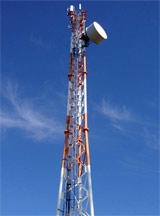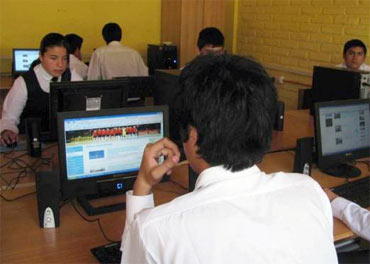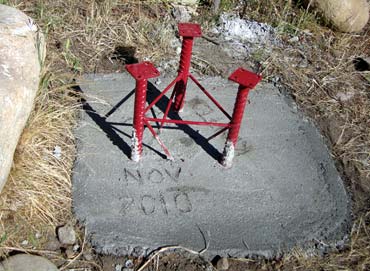Chilean rural community gets access to information thanks to UNESCO-supported project
14-12-2010 (Los Queñes)

Radio tower, Los Queñes
© UNESCO
Last month, a high-speed wireless Internet connection was installed in the Andean town of Los Queñes as part of an innovative connectivity initiative to bridge the digital gap in rural areas of Chile. This project, implemented by UNESCO’s Office in Santiago, the Regional Government of Maule, the University of Talca and the city of Romeral, provides the citizens and schools of the Maule region with access to information and new opportunities.
Tree wireless Internet (Wi-Fi) antennas have been installed allowing the creation of a community multimedia centre (CMC), which strengthened the local radio service. With speeds equivalent to the services available in an urban area of the region, the wireless connection enables rural residents to access new job and training opportunities, helps to boost tourism and develop local production.
"We're especially interested in supporting the community and generating new opportunities through access to information and knowledge," says Gloria Alberti, from UNESCO’s Santiago Office.
"This is also a possibility to build a fairer situation for lower-income residents in remote Andean areas, who will now be able to share their culture, history and productive activities with the world," adds Miguel Valenzuela, from the Maule regional government.
The initiative came about in 2006 as part of a project carried out by the Engineering Faculty at UTALCA and prompted by two students who based their undergraduate thesis on implementing a long-distance Internet and telephone system for a rural clinic. Initial activities were financed by Empresas Bravo and Bío Bío. Later a project backed by OREALC and UNESCO’s Santiago Office made it possible to install the system definitively and to ensure its launch this year.
The city of Romeral has provided a great support in developing this rural Internet project, which demonstrates "great social and technological progress in the town," according to the city official Luis Lobos, who added that mayor Carlos Cisterna Negrete purchased two 36-meter radio towers.
"We are proud of our students. This is a perfect example of the University's role in the region: sharing knowledge for the well-being of local residents," said Professor Per Bro, who oversees the project. He emphasised that this initiative, which has been implemented thanks to support from a variety of players both from the public and private sectors, is a boon to the community.
Located 37 kilometres from Romeral and traditionally isolated, the Los Queñes community organized its first community multimedia centre in 2008. UNESCO's International Programme for the Development of Communication (IPDC) approved a new US$11,400 project to be developed in 2010-2011. Resources will be used to train community members, which will enable them to become involved in technical and communication activities at the community radio station and to ensure the web site maintenance. The IPDC funds will also be used for purchasing equipment to expand the radio service, which is currently an important medium that reaches all of the nearby towns (7,000 people), and for financing local programmes through an IPTV transmitter.
Maule, via its regional government, is the pilot region receiving support from OREALC and UNESCO. Community multimedia centres are part of the initiative that UNESCO is developing in South America and around the world to bridge the digital gap in isolated areas and to enable communities through access to the Internet and other technologies.
"We're especially interested in supporting the community and generating new opportunities through access to information and knowledge," says Gloria Alberti, from UNESCO’s Santiago Office.
"This is also a possibility to build a fairer situation for lower-income residents in remote Andean areas, who will now be able to share their culture, history and productive activities with the world," adds Miguel Valenzuela, from the Maule regional government.
The initiative came about in 2006 as part of a project carried out by the Engineering Faculty at UTALCA and prompted by two students who based their undergraduate thesis on implementing a long-distance Internet and telephone system for a rural clinic. Initial activities were financed by Empresas Bravo and Bío Bío. Later a project backed by OREALC and UNESCO’s Santiago Office made it possible to install the system definitively and to ensure its launch this year.
The city of Romeral has provided a great support in developing this rural Internet project, which demonstrates "great social and technological progress in the town," according to the city official Luis Lobos, who added that mayor Carlos Cisterna Negrete purchased two 36-meter radio towers.
"We are proud of our students. This is a perfect example of the University's role in the region: sharing knowledge for the well-being of local residents," said Professor Per Bro, who oversees the project. He emphasised that this initiative, which has been implemented thanks to support from a variety of players both from the public and private sectors, is a boon to the community.
Located 37 kilometres from Romeral and traditionally isolated, the Los Queñes community organized its first community multimedia centre in 2008. UNESCO's International Programme for the Development of Communication (IPDC) approved a new US$11,400 project to be developed in 2010-2011. Resources will be used to train community members, which will enable them to become involved in technical and communication activities at the community radio station and to ensure the web site maintenance. The IPDC funds will also be used for purchasing equipment to expand the radio service, which is currently an important medium that reaches all of the nearby towns (7,000 people), and for financing local programmes through an IPTV transmitter.
Maule, via its regional government, is the pilot region receiving support from OREALC and UNESCO. Community multimedia centres are part of the initiative that UNESCO is developing in South America and around the world to bridge the digital gap in isolated areas and to enable communities through access to the Internet and other technologies.
 Students using the Internet for the first time.
Students using the Internet for the first time.© UNESCO
 Installation of wireless Internet antennas and radio towers, Los Queñes.
Installation of wireless Internet antennas and radio towers, Los Queñes.© UNESCO
Related themes/countries
· Chile
· International Programme for the Development of Communication (IPDC)
· Access to Information
Share this story:
Contact information
- UNESCO
Source














